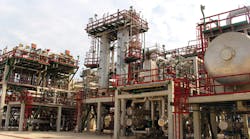Warren R. True
OGJ Chief Technology Editor-LNG/Gas Processing
HOUSTON, June 11 -- Chinese refinery production of LPG fell for the first time in history last year. At the same time, the country’s imports of LPG continued in 2008 a decline begun in 2005 and Chinese LPG consumption fell for the first time since 2000.
These are the major conclusions of a report by Lijuan Wang and Kang Wu of FACTS Global Energy, Singapore, issued June 9.
For 2009, the authors forecast that China’s LPG output will recover as a result of expected higher refinery crude runs when a couple of local refineries come online. Imports, however, will continue their slide, while exports will “increase moderately.”
LPG consumption in 2009 will recover only slightly, as markets continue to suffer from the global economic slump and natural gas makes inroads into traditional LPG demand.
Production
Sources for China’s LPG output in 2008 were Sinopec refineries (50%), PetroChina refineries (30%), and local refineries (20%). Supply from these sources made up 87.3% of China’s total LPG; the remaining 12.7% came from the Middle East, Australia, Asia, and other countries.
Domestic output last year reached 589,400 b/d, down 4.1% from 2007, said the report, the “first time that China [had ever seen] a decrease in LPG output.” Two factors lie behind the decline: Local refineries increased production of both gasoline and diesel through the first three quarters of 2008 to supply the Beijing 2008 Olympics; and weak domestic LPG demand pushed output lower in final quarter.
China’s LPG production profile differs drastically from that of almost every other LPG producing country in the world. Globally, LPG production on average comes about 60% from gas processing with the great majority of the remainder from refinery operations.
According to OGJ data for 2008, China operated only two gas processing plants. Both were operated by Petrochina in the Ordos basin with total inlet capacity of 774 MMcfd. No throughput or production data were available for 2008 (OGJ, June 22, 2009).
Imports, exports
The decline in China’s LPG imports since 2005 accelerated last year, according to the FGE report, averaging 82,400 b/d, down 36.1% from 2007. The authors explained that a sharp increase in international prices during first-half 2008 combined with weaker demand during second half were behind the decline.
On the other hand, China’s LPG exports since 2005 have been rapidly increasing, to 21,400 b/d in 2008 from 800 b/d in 2005.
Again, a major explanation can be found in the higher international prices, while Chinese refineries faced negative margins overall in domestic markets last year. China’s LPG prices are controlled by its government.
The report’s authors also explained that the geographical differences “for this huge country is another reason why China exports LPG, while importing it.”
Yet another explanation for imports and for Chinese producers’ looking last year to international markets is the drop in domestic consumption In a reversal of a steady increase 2002-07, Chinese consumption of LPG in 2008 dropped to an average 652,200 b/d, down 11% from 2007.
Most of the LPG in China is consumed as fuel by the residential sector accounting for 65% of the total, said the FGE report. Another 25% is consumed by the industrial sector, 2% for vehicle use, and 8% for other uses.
By region, South China and East China are main consumers of LPG.
Guangdong Province is the largest importer of LPG in China, according to the report, “even as imports declined in recent years.” Guangdong’s in 2008, however, dropped to 56,000 b/d from 92,600 b/d in 2007 and 121,300 b/d in 2006.
Sources
Of China’s 82,400 b/d imports in 2008, 70,500 b/d (85.6%) came from Middle East countries: 17,000 b/d from the UAE, 16,100 b/d from Kuwait, 15,100 b/d from Saudi Arabia, 14,100 b/d from Iran, and 8,200 b/d from Qatar.
About 80% of LPG imports was imported by foreign-owned companies or joint-venture companies with a foreign base, said the report.
Contact Warren R. True at [email protected].
